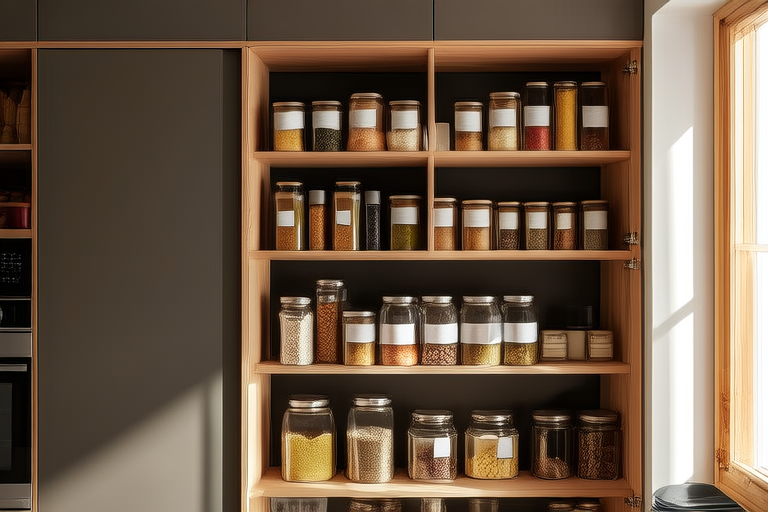How to Design an Organized Pantry: A Complete Guide for Every Home Cook
Introduction
An organized pantry is not just about aesthetics; it’s about efficiency, convenience, and saving time. Whether you’re a seasoned chef or a beginner in the kitchen, having a well-organized pantry can make meal preparation smoother and more enjoyable. A cluttered pantry can lead to wasted ingredients, forgotten items, and unnecessary trips to the grocery store. In this guide, we’ll explore how to design an organized pantry that suits your needs, maximizes space, and keeps everything within easy reach.
Understanding Your Needs
Before diving into organizing your pantry, take some time to assess your current situation and future goals. This step is crucial because every home cook has different preferences and requirements.
Assess Your Inventory
Start by taking inventory of what you already have. Remove expired or unused items. This process will help you identify gaps in your stock and avoid overbuying. You might be surprised at how much space you free up once you clear out unnecessary items.
Determine Your Storage Needs
Think about the types of food you frequently use. Do you prefer dry goods like grains, pasta, and canned foods? Or do you often use spices, oils, and condiments? Knowing your storage needs will guide you in choosing the right containers and shelves.
Consider Accessibility
Make sure the most frequently used items are easily accessible. Place heavier items on lower shelves and lighter items on higher ones. This arrangement will prevent strain and make it easier to grab what you need quickly.
Optimize Space with Smart Shelving
Once you’ve assessed your needs, it’s time to optimize your pantry space. Proper shelving is key to keeping everything organized and within reach.
Use Vertical Space
Vertical space is often underutilized. Install adjustable shelves to maximize height and accommodate various container sizes. Consider adding shelf dividers to keep smaller items from rolling around.
Utilize Drawer Systems
Drawers are perfect for storing bulkier items like baking sheets, cutting boards, and mixing bowls. They provide easy access and keep these items from cluttering your countertops.
Invest in Bins and Containers
Bins and containers are essential for keeping similar items together. Use transparent bins so you can see what’s inside without opening them. Label each bin clearly to avoid confusion.
Keep It Clean and Tidy
A clean and tidy pantry not only looks better but also ensures that all your food stays fresh longer.
Regular Cleaning
Set a regular cleaning schedule to wipe down shelves and surfaces. This will prevent dust accumulation and make it easier to spot any spills or leaks.
Rotate Stock
Practice the “first-in, first-out” (FIFO) method to ensure that older items get used before they expire. This simple technique can save you money and reduce waste.
Label Everything
Labeling is one of the most effective ways to keep track of your inventory. Use labels for expiration dates, contents, and even quantities. This will help you stay organized and avoid buying duplicates.
Practical Tips and Case Studies
Here are some practical tips and real-life examples to inspire your pantry organization journey.
Case Study: Small Urban Kitchen
In a small urban apartment, space is at a premium. One solution is to install pull-out shelves that extend from the wall. These shelves provide extra storage while making it easier to reach items in the back. Another idea is to use stackable containers for spices and herbs, keeping them neatly organized and easily accessible.
DIY Solutions
If budget constraints are an issue, consider DIY solutions. For example, repurposing old jars and cans as decorative containers can add a personal touch to your pantry. You can also create hanging organizers using wire baskets to hang spices and small tools.
Conclusion
Designing an organized pantry requires careful planning and thoughtful execution. By understanding your needs, optimizing space, and maintaining cleanliness, you can create a pantry that enhances your cooking experience. Remember, the goal is not just to have a neat and tidy pantry but also to make meal preparation more efficient and enjoyable. Start by assessing your current situation, then gradually implement changes based on your needs and preferences. With a little effort, you’ll soon enjoy the benefits of a well-organized pantry.
Actionable Steps:
- Take Inventory: Clear out expired or unused items.
- Assess Storage Needs: Identify the types of food you use most frequently.
- Optimize Space: Install adjustable shelves and use bins and containers.
- Maintain Cleanliness: Regularly clean and rotate stock.
- Label Everything: Ensure clarity and prevent confusion.
By following these steps, you’ll be well on your way to creating a pantry that not only looks great but also functions efficiently. Happy organizing!
